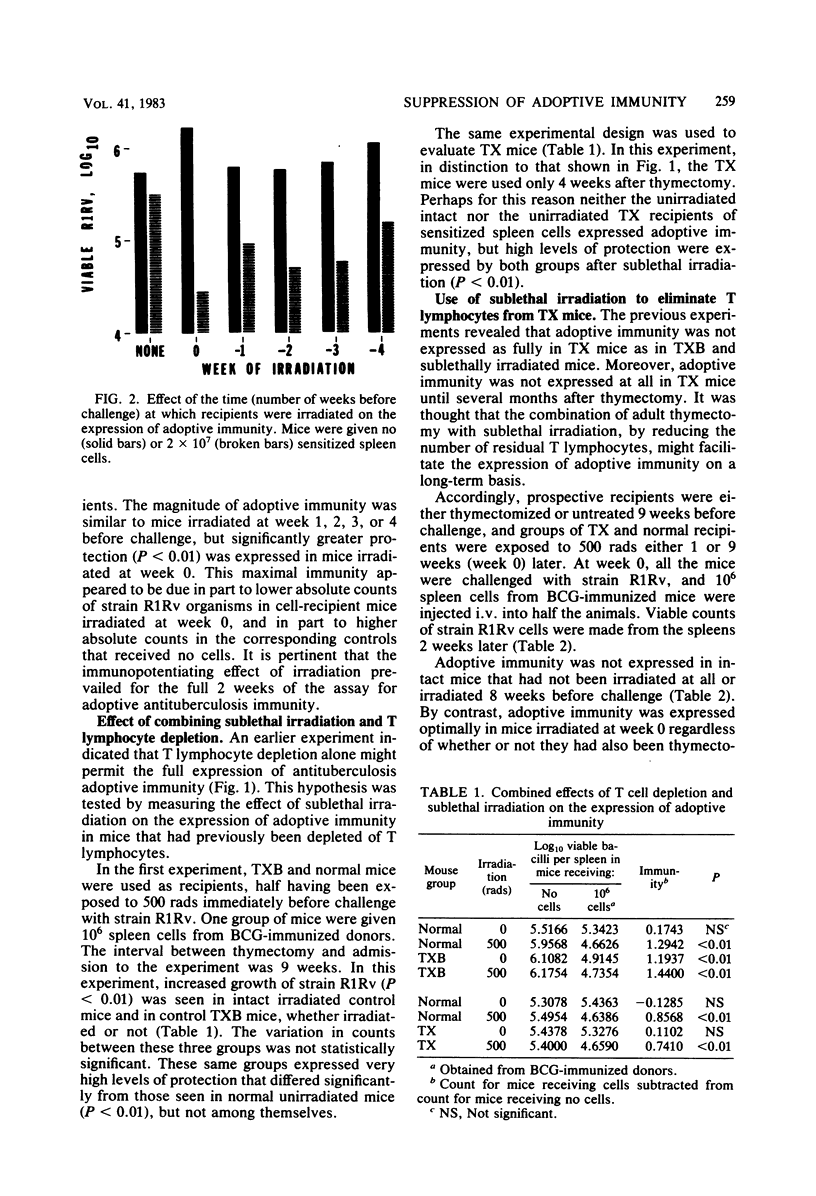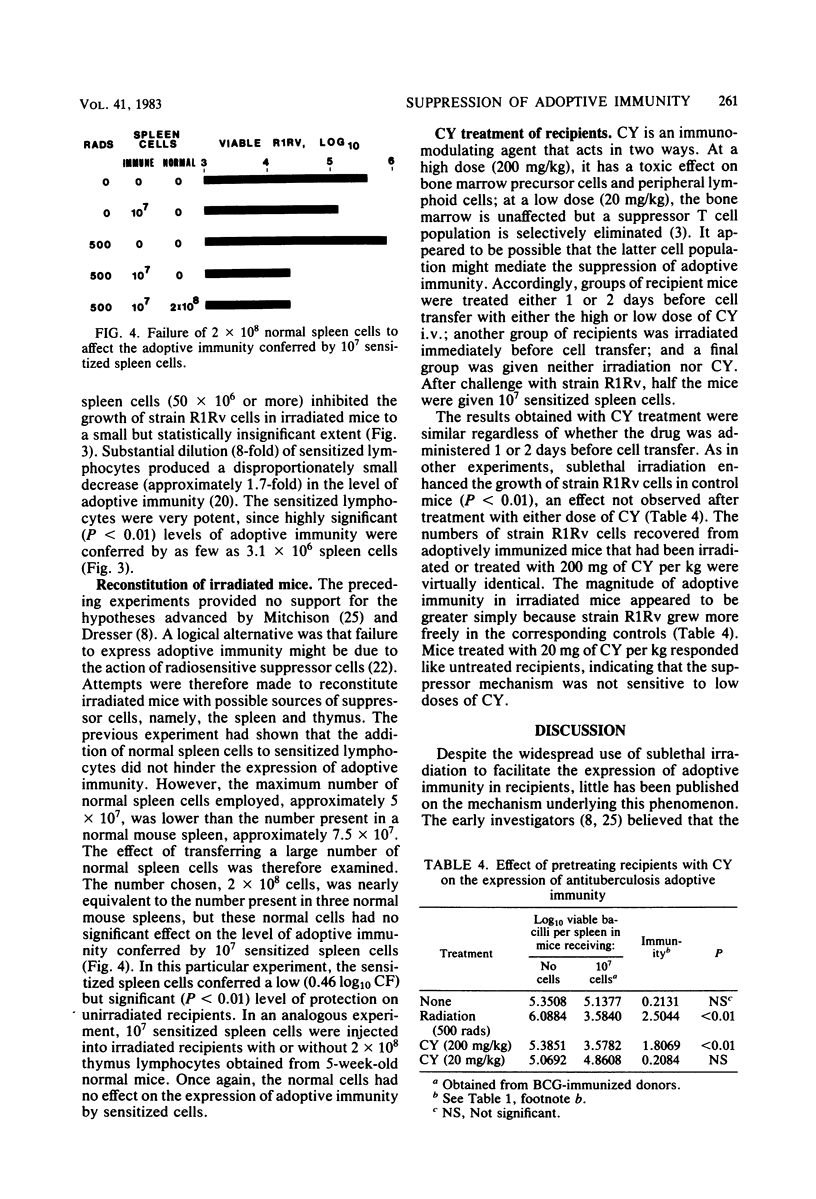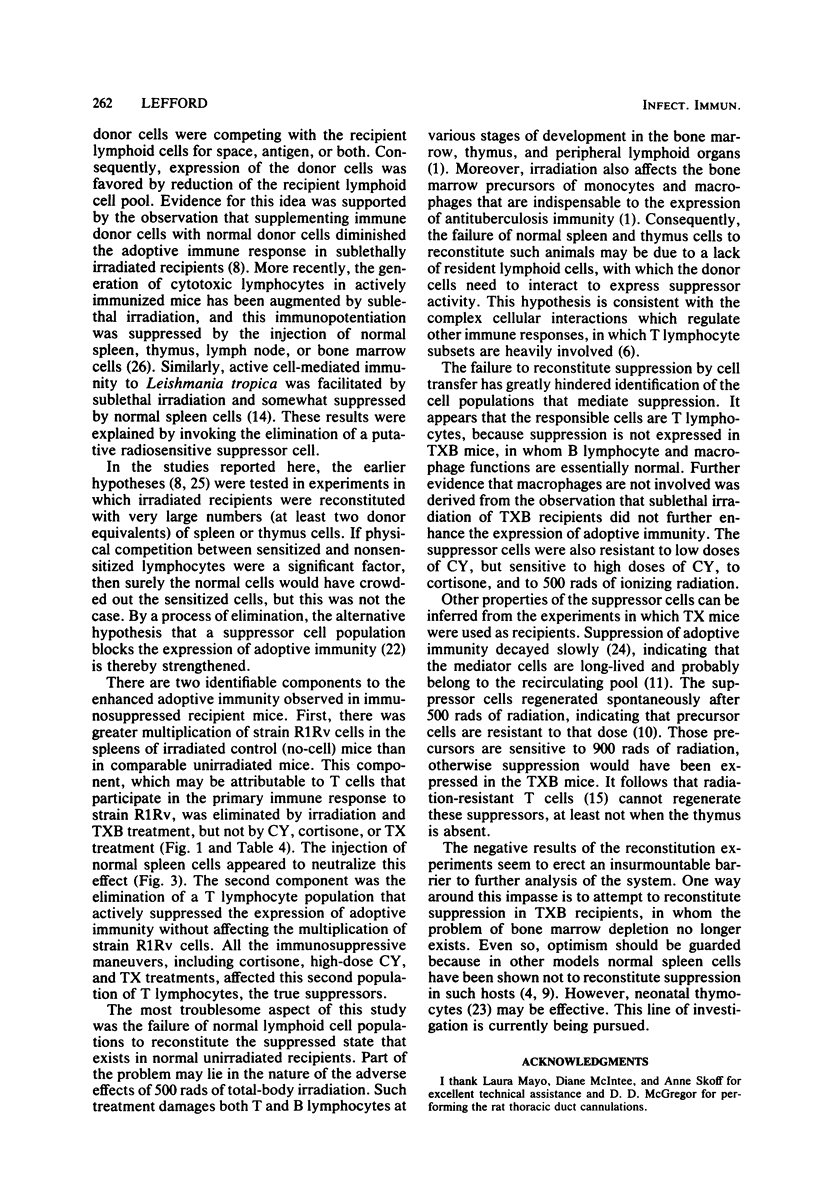Abstract
Adoptive immunity is poorly expressed in normal syngeneic mice. This phenomenon was studied by using experimental antituberculosis immunity as a model system representing pure cell-mediated immunity. Expression of adoptive immunity was facilitated by pretreating recipients with sublethal ionizing radiation (500 rads) or high doses (200 mg/kg) of cyclophosphamide or by using adult thymectomized, lethally irradiated, bone-marrow-reconstituted (TXB) mice. Adult thymectomy was less effective, and a low dose of cyclophosphamide (20 mg/kg) was completely ineffective. The beneficial effect of sublethal irradiation was reduced over time; it persisted for 4 weeks and was absent after 8 weeks. Attempts to restore the suppressed state of normal mice to sublethally irradiated mice by using normal spleen or thymus cells did not succeed. Even in rats, which express adoptive antituberculosis immunity without immunosuppressive treatment, the use of sublethally irradiated or TXB recipients potentiated adoptive immunity. It was concluded that suppression of adoptive immunization in normal recipient mice is mediated predominantly, if not exclusively, by T lymphocytes that are sensitive to a number of immunosuppressive agents. The suppressor cells are long-lived and can be regenerated from precursors that are resistant to 500 but not to 900 rads of ionizing radiation.
Full text
PDF






Selected References
These references are in PubMed. This may not be the complete list of references from this article.
- Anderson R. E., Warner N. L. Ionizing radiation and the immune response. Adv Immunol. 1976;24:215–335. doi: 10.1016/s0065-2776(08)60331-4. [DOI] [PubMed] [Google Scholar]
- Asherson G. L., Zembala M. Contact sensitivity in the mouse. IV. The role of lymphocytes and macrophages in passive transfer and the mechanism of their interaction. J Exp Med. 1970 Jul 1;132(1):1–15. doi: 10.1084/jem.132.1.1. [DOI] [PMC free article] [PubMed] [Google Scholar]
- Askenase P. W., Hayden B. J., Gershon R. K. Augmentation of delayed-type hypersensitivity by doses of cyclophosphamide which do not affect antibody responses. J Exp Med. 1975 Mar 1;141(3):697–702. doi: 10.1084/jem.141.3.697. [DOI] [PMC free article] [PubMed] [Google Scholar]
- Berendt M. J., North R. J. T-cell-mediated suppression of anti-tumor immunity. An explanation for progressive growth of an immunogenic tumor. J Exp Med. 1980 Jan 1;151(1):69–80. doi: 10.1084/jem.151.1.69. [DOI] [PMC free article] [PubMed] [Google Scholar]
- Boyle W. An extension of the 51Cr-release assay for the estimation of mouse cytotoxins. Transplantation. 1968 Sep;6(6):761–764. doi: 10.1097/00007890-196809000-00002. [DOI] [PubMed] [Google Scholar]
- Cantor H., Gershon R. K. Immunological circuits: cellular composition. Fed Proc. 1979 Jun;38(7):2058–2064. [PubMed] [Google Scholar]
- Celada F. Quantitative studies of the adoptive immunological memory in mice. I. An age-dependent barrier to syngeneic transplantation. J Exp Med. 1966 Jul 1;124(1):1–14. doi: 10.1084/jem.124.1.1. [DOI] [PMC free article] [PubMed] [Google Scholar]
- DRESSER D. W. A study of the adoptive secondary response to a protein antigen in mice. Proc R Soc Lond B Biol Sci. 1961 Jul 25;154:398–417. doi: 10.1098/rspb.1961.0039. [DOI] [PubMed] [Google Scholar]
- Dye E. S., North R. J. T cell-mediated immunosuppression as an obstacle to adoptive immunotherapy of the P815 mastocytoma and its metastases. J Exp Med. 1981 Oct 1;154(4):1033–1042. doi: 10.1084/jem.154.4.1033. [DOI] [PMC free article] [PubMed] [Google Scholar]
- GLOBERSON A., FELDMAN M. ROLE OF THE THYMUS IN RESTORATION OF IMMUNE REACTIVITY AND LYMPHOID REGENERATION IN IRRADIATED MICE. Transplantation. 1964 Mar;2:212–227. doi: 10.1097/00007890-196403000-00006. [DOI] [PubMed] [Google Scholar]
- GROSS L. Effect of thymectomy on development of leukemia in C3H mice inoculated with leukemic passage virus. Proc Soc Exp Biol Med. 1959 Feb;100(2):325–328. doi: 10.3181/00379727-100-24615. [DOI] [PubMed] [Google Scholar]
- HARRIS T. N., HARRIS S., BEALE H. D., SMITH J. J. Studies on the transfer of lymph node cells. IV. Effects of X-irradiation of recipient rabbits on the appearance of antibody after cell transfer. J Exp Med. 1954 Sep 1;100(3):289–300. doi: 10.1084/jem.100.3.289. [DOI] [PMC free article] [PubMed] [Google Scholar]
- Howard J. G., Hale C., Liew F. Y. Immunological regulation of experimental cutaneous leishmaniasis. IV. Prophylactic effect of sublethal irradiation as a result of abrogation of suppressor T cell generation in mice genetically susceptible to Leishmania tropica. J Exp Med. 1981 Mar 1;153(3):557–568. doi: 10.1084/jem.153.3.557. [DOI] [PMC free article] [PubMed] [Google Scholar]
- Kataoka Y., Sado T. The radiosensitivity of T and B lymphocytes in mice. Immunology. 1975 Jul;29(1):121–130. [PMC free article] [PubMed] [Google Scholar]
- Lefford M. J. Immunization of mice after airborne infection with various strains of BCG. Am Rev Respir Dis. 1978 Jan;117(1):103–109. doi: 10.1164/arrd.1978.117.1.103. [DOI] [PubMed] [Google Scholar]
- Lefford M. J. Induction and expression of immunity after BCG immunization. Infect Immun. 1977 Dec;18(3):646–653. doi: 10.1128/iai.18.3.646-653.1977. [DOI] [PMC free article] [PubMed] [Google Scholar]
- Lefford M. J., Logie P. S. Induction and suppression of cross-reactive antituberculosis immunity after Mycobacterium lepraemurium infection of mice. Infect Immun. 1981 Mar;31(3):1023–1033. doi: 10.1128/iai.31.3.1023-1033.1981. [DOI] [PMC free article] [PubMed] [Google Scholar]
- Lefford M. J. Macrophage activation and resistance to pulmonary tuberculosis. Infect Immun. 1980 May;28(2):508–515. doi: 10.1128/iai.28.2.508-515.1980. [DOI] [PMC free article] [PubMed] [Google Scholar]
- Lefford M. J., McGregor D. D., Mackaness G. B. Immune response to Mycobacterium tuberculosis in rats. Infect Immun. 1973 Aug;8(2):182–189. doi: 10.1128/iai.8.2.182-189.1973. [DOI] [PMC free article] [PubMed] [Google Scholar]
- Lefford M. J. Transfer of adoptive immunity to tuberculosis in mice. Infect Immun. 1975 Jun;11(6):1174–1181. doi: 10.1128/iai.11.6.1174-1181.1975. [DOI] [PMC free article] [PubMed] [Google Scholar]
- MITCHISON N. A. Adoptive transfer of immune reactions by cells. J Cell Physiol Suppl. 1957 Dec;50(Suppl 1):247–264. doi: 10.1002/jcp.1030500416. [DOI] [PubMed] [Google Scholar]
- McCullagh P. Radiosensitivity of suppressor cells in newborn rats. Aust J Exp Biol Med Sci. 1976 Oct;53(5):399–411. doi: 10.1038/icb.1975.45. [DOI] [PubMed] [Google Scholar]
- McCullagh P. Role of the thymus in suppression of immune responses in newborn rats. Aust J Exp Biol Med Sci. 1976 Oct;53(5):413–420. doi: 10.1038/icb.1975.46. [DOI] [PubMed] [Google Scholar]
- Miller J. F. Effect of thymectomy in adult mice on immunological responsiveness. Nature. 1965 Dec 25;208(5017):1337–1338. doi: 10.1038/2081337a0. [DOI] [PubMed] [Google Scholar]
- Sabbadini E. Regulation of cell-mediated cytotoxicity. I. Augmentation of cell-mediated cytotoxicity induced by radiation. J Exp Med. 1974 Aug 1;140(2):470–480. doi: 10.1084/jem.140.2.470. [DOI] [PMC free article] [PubMed] [Google Scholar]
- Zembala M., Asherson G. L. The effect of cyclophosphamide and irradiation on cells which suppress contact sensitivity in the mouse. Clin Exp Immunol. 1976 Mar;23(3):554–561. [PMC free article] [PubMed] [Google Scholar]


